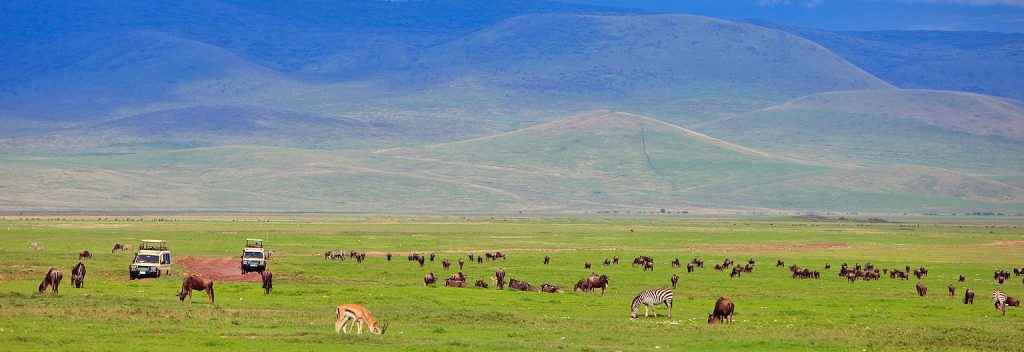
One of Africa’s Most Iconic Wildlife Destinations
Often described as the “eighth wonder of the world,” the Ngorongoro Crater is one of Africa’s most celebrated natural landmarks. With the highest density of wildlife in Africa, it offers an unmatched safari experience. Although the popularity of the crater means you’ll likely share the space with other vehicles, the incredible scenery and exceptional wildlife viewing more than make up for it.
There’s truly nowhere else in Africa quite like Ngorongoro.
A Geological Marvel
The Ngorongoro Crater is the world’s largest intact volcanic caldera, spanning approximately 265 square kilometers with walls rising as high as 600 meters. This natural amphitheater was formed millions of years ago when a massive volcano collapsed, creating the lush, enclosed ecosystem seen today.
From the crater rim, which sits at over 2,200 meters (7,200 ft) above sea level, you can enjoy breathtaking views across the crater floor. On most days, the rim is shrouded in clouds, creating a mystical atmosphere—and due to its altitude, it can get surprisingly chilly, especially at night.
Diverse Habitats and Ecosystems
The crater floor is a mosaic of ecosystems, including:
-
Open grasslands where herds of zebra and wildebeest graze
-
Swamps and forests that shelter elephants and hippos
-
Lake Makat (Lake Magadi)—a shallow soda lake fed by the Munge River, attracting flocks of flamingos
-
Freshwater springs and wooded areas ideal for birdwatching and spotting elusive predators
Although animals can move in and out of the crater, the fertile volcanic soil, permanent water sources, and steep crater walls keep many species resident year-round.
Wildlife Highlights in the Ngorongoro Crater
The Ngorongoro Crater offers one of the best chances in Tanzania to spot the critically endangered Black Rhino. A small but healthy population lives within the crater, one of the few places where they continue to breed in the wild.
Other notable wildlife includes:
-
Black-maned lions
-
Leopards, often seen lounging in the trees
-
Large herds of buffalo, zebra, wildebeest, and gazelles
-
Elephants with impressive tusks
-
Thousands of flamingos at Lake Magadi, drawn by its mineral-rich waters
Whether you’re a first-time safari-goer or a seasoned traveler, the wildlife spectacle here is truly extraordinary.
Cultural Encounters: Visit a Maasai Village
The Ngorongoro Conservation Area is not only a wildlife sanctuary but also a cultural heritage site for the Maasai people, who were relocated from the Serengeti Plains. Traditionally nomadic pastoralists, the Maasai live in temporary bomas—circular homesteads made of mud, sticks, and cow dung.
Tourists have the opportunity to visit these villages and:
-
Learn about Maasai customs, traditions, and architecture
-
See the chronological arrangement of huts based on the order of wives
-
Experience life inside a cow dung hut, warmed by a central fire
-
Witness traditional dances and hear stories passed down through generations
While they no longer reside within the crater itself, the Maasai still bring their cattle to graze and drink—sharing the landscape with lions, hyenas, and other predators in a coexistence that’s both daring and fascinating.
Why Visit the Ngorongoro Crater?
A trip to the Ngorongoro Crater offers:
-
Exceptional year-round wildlife viewing
-
A stunning, unique landscape shaped by ancient geology
-
A rich cultural experience with the Maasai
-
Proximity to other Tanzania safari hotspots like Serengeti and Lake Manyara
Whether you’re chasing the Big Five or simply marveling at the scenery, Ngorongoro promises an unforgettable addition to your East African adventure.
